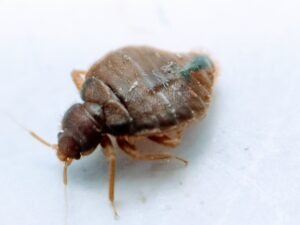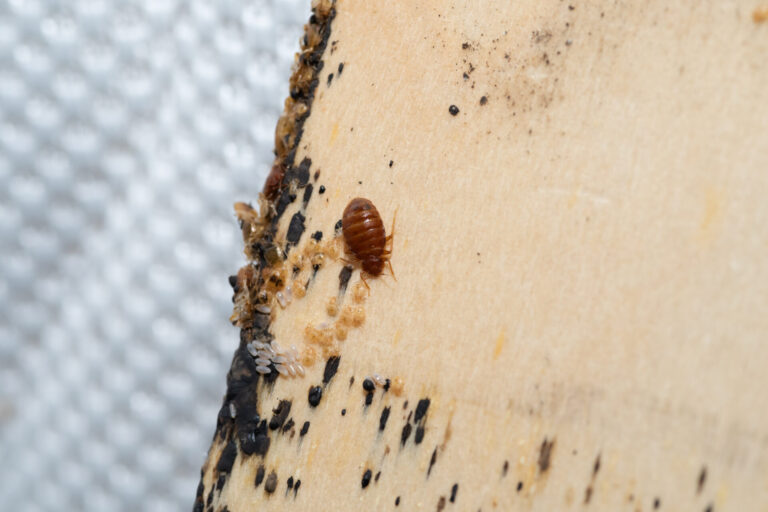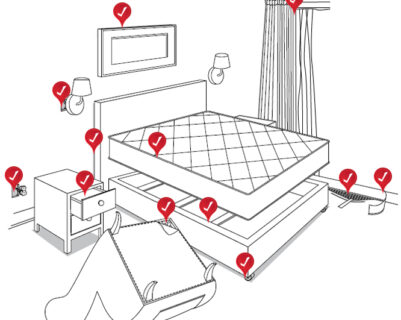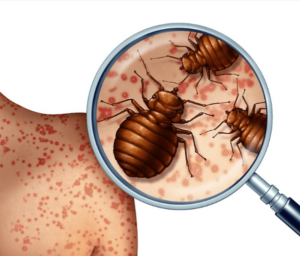15% discount on all bed bug heat treatment services.
30 Days Complete Eradication Guarantee*
15% discount on all bed bug heat treatment services.
30 Days Complete Eradication Guarantee*
If you’ve ever had bed bug bites, you’ll know the irritation they cause: not only the itching and scratching, but the thought that hundreds of these little creatures are sharing your bed every night.

Bed bugs are small, reddish-brown insects that dwell in beds, furnishings and other items, feeding on human blood.
Adult bed bugs are around the size of an apple seed. They are flat, oval in shape and wingless—and require regular meals of human blood to survive and flourish.
They are active at night and usually bite sleepers, piercing the skin and feeding through long beaks. Each feed takes around 3–10 minutes.
After feeding, bed bugs swell up and turn a deeper reddish colour. In favourable conditions, young bed bugs (“nymphs”) can develop fully in as little as a month. They live for around 10–12 months and can produce three or more generations of little ones in that time.
Infestations can be difficult to detect with the untrained eye—over 50 percent of bed bug infestations go unnoticed. These bugs don’t make nests like other insects, so you need to identify an infestation by spotting groups of individual creatures in their hiding places.
A true bed bug exterminator will, however, be able to identify the presence of bed bugs and eliminate them from rooms and entire properties (more about this below).
“But I heard that bed bugs are invisible…”
That’s not true. Bed bugs are small and very good hiders but they are visible. Nymphs may be almost impossible to see because they are translucent or yellowish in colour.
With fully grown bugs measuring around 4-5mm, they are easily visible—if you’re looking in the right places.
Once inside a room, the bugs will flatten themselves and hide in the tiniest of spaces, such as plug sockets and folds or creases in bedding and mattresses.
Bedbug eggs are tiny in size (about the size of a speck of dust) and white in colour.

Bed bugs have lived where humans have lived for thousands of years. They follow us all over the world and can flourish in types of climates. They’re common in developed countries like the UK, the U.S. and Canada as well as developing countries.

Because of the unique flat shape of bed bugs, they can infiltrate just about anywhere—and will attempt to set up home as long as there is blood to feed on. This needn’t be human blood, either; they’re not fussy and will feed on the blood of any warm-blooded animals, including poultry and other birds.
Though they can’t fly, bed bugs can travel up to one metre per minute over floors, walls and ceilings., so they are quite mobile and good at finding new homes.
Though bed bugs (as their name suggests) are mostly associated with living inside mattresses and other bedding, they infest other items too. In fact, bed bugs can live in any type of upholstered furniture or luggage.
Most commonly, bed bug infestations affect the following types of properties:
A bed bug infestation in a home or other building is caused by an invasion from another place that’s infested with them.
For instance, they can travel between units in an apartment building. They are also excellent “hitchers” and can latch onto upholstered furniture or even luggage that you take with you or a handbag that was placed in an infested room.
Bed bug bites can be itchy and very annoying but rarely pose any risk to human health.
You may develop red or purple bite marks on your skin (often in clusters of bites or straight lines/zigzags) but there’s no evidence that bed bug bites can spread disease.
The main health issues associated with such bites are infected bite marks: they can often be so itchy that people scratch them and break the skin. Another potential health issue is allergies to bed bug bites.
Most people suffer little reaction after bed bug bites and even bite marks can take two weeks to show (again making them so difficult to detect) but an allergic reaction could mean the bites become intolerable and you’ll need to see a doctor for treatment.
You should see a doctor if you experience excessive itching (hives) or blistering.
Another possible health issue from bed bugs is insomnia—because people who sleep in an infested room may be too anxious to sleep.

Bed bug bite marks may appear on any exposed part of the body, including the face, neck, arms shoulders or hands.
Unlike flea bites, bed bug bites don’t have a red spot in the centre. There are, however, some clear warning signs to be on the lookout for with bed bugs.
The most obvious sign that you need to call a bed bug exterminator is the itchy skin and red or purple marks that appear. If the bedbugs are mature, you may even be able to spot them in your bed or upholstery.
Other possible signs of a bed bug infestation include:
Many of these signs will be detected only by pest control professionals and can be tough for a homeowner to identify.
If you suspect a bed bug infestation, ThermoPest offers a highly reliable K9 detection survey to confirm your concerns. Our expertly trained detection dogs can quickly and accurately identify the presence of bed bugs, even in the most hidden areas. By choosing ThermoPest’s K9 detection service, you’ll receive a thorough inspection that ensures no infestation goes unnoticed, helping you take swift action to protect your home or business from these unwelcome pests.
As with most pest problems, prevention is better than cure. Take a few of the following steps to prevent bed bugs from invading your home or business:
The most common treatments used by bed bug exterminators are chemical treatments and sprays—but these aren’t always the most effective (even after multiple visits to a property).
With the advances in technology, heat treatment is now considered the most effective way to eliminate bed bugs permanently. This requires a professional bed bug exterminator and specialist equipment that heats the room for a certain length of time to kill the bugs.
At ThermoPest, we use high-powered convection heaters and other equipment to raise and hold the temperature to between 49°C and 60°C for precisely the right period to eliminate infestations from egg stage to adults.
The only option if you want to solve a bed bug problem is to eliminate every bug in every possible hiding place. Chemicals rarely achieve that but heat treatment does, penetrating every crack and fold. A single visit is all that’s required and most infestations can be eliminated in a single day.
Remember, bed bug extermination is most effective when the pests are detected early and eradicated completely. At ThermoPest, we offer a unique 30-day guarantee for our heat-based bed bug elimination treatments…
Yes, bed bugs are small but visible—though they are very good at
flattening themselves and hiding. Once fully grown, the bugs are red/
brown and measure around 4-5mm. Can you see bed bugs?
Bed bugs can be found anywhere that humans live because they feed on human blood. This attracts them to any environment where they can hide out—with mattresses and upholstery the prime targets. What causes bed bugs?
Bed bugs are difficult to identify in the early stages of their life cycles. Most infestations are discovered due to bite marks and itching from residents. Pest control professionals can usually identify droppings on bedding, uncover the places where the bugs hide and even smell the strong, sweet odours of a mature infestation. What are the signs that I have bed bugs?
Getting rid of bed bugs is not an easy task for anyone to undertake. Predominately, this is due to the nocturnal nature and ability for the bed bugs to hide in small cracks and crevices. When there a sightings of bed bugs, it normally indicates that there is a serious bed bug infestation. How do I kill bed bugs?
Preventing bed bugs from entering your home or business is a difficult task, they are usually picked up whilst travelling and are difficult to see, but by taking small measures you can help prevent bed bug infestations. How to prevent bed bugs
Commonly we are asked what do bed bug bites look like? The problem with bed bug bites is that they can be easily confused with other insect’s bites. Each individual that has been bitten by bug beds will react differently therefore its not always easy to know, however there are some indicators. What do bed bug bites look like?
Bed bugs are very tiny insects that can cause a bit of trouble if you happen to have an infestation. They are oval, flat and brownish, almost like apple’s seeds, but they are incredibly tiny, so they are a bit hard to spot. They owe their name to their tendency to hide in areas that are related to the bed, such as a mattress, pillows, box springs, bed frames, and other furniture. They usually remain close to the host and usually bite at night when we are sleeping. Where do bed bugs bite?
Bed bugs are found in virtually any place people tend to gather, including residences, hotels, schools, offices, retail stores and even public transportation. Bed bugs will remain as close to their host as possible and feed during the night, which is why you will usually get bitten whilst sleeping. If you need a bed bug exterminator near you, get in contact with one of our team today. Where do bed bugs come from?
Bed bug heat treatment is a method used to eliminate bedbugs by subjecting them to high temperatures. This approach relies on the sensitivity of bedbugs to heat, as they cannot survive when exposed to temperatures above a certain threshold. How to get rid of bed bugs?
In the near future, we hope to be able to offer payment plans to fund bed bug treatments.

Talk to us about Bed Bug Pest Control
Call us on 0808 189 2310 - or complete our Free Quote Form below.
Learn about our Bed Bug Pest Control Services
Free Quote
Free Quote for all Bed Bug Heat Treatment Services Nationwide

Industry Experts
Leading experts in bed bug control

Emergency Call-outs
Guaranteed quick and rapid responses to urgent infestations

Contract Work
For ongoing problems, use our preventative contracts
Free Quote
Free Quote for all Bed Bug Treatments Nationwide
"*" indicates required fields
Free Quote
Free Quote for all Bed Bug Treatments Nationwide
"*" indicates required fields